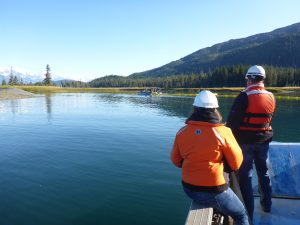 Urging expeditious action by the Governor of Alaska and the Alaska Legislature to amend the existing State Oil and Hazardous Substances Release Prevention and Response Fund funding mechanisms and, as may be necessary, to establish requisite ancillary funding mechanisms to support and sustain an adequately robust oil and hazardous substances release prevention and response program.
Urging expeditious action by the Governor of Alaska and the Alaska Legislature to amend the existing State Oil and Hazardous Substances Release Prevention and Response Fund funding mechanisms and, as may be necessary, to establish requisite ancillary funding mechanisms to support and sustain an adequately robust oil and hazardous substances release prevention and response program.
WHEREAS, the State of Alaska’s Oil and Hazardous Substance Release Prevention and Response Fund (470 Fund) is supported through a 5-cent per barrel surcharge on crude oil production which represents the key funding mechanism for the major components of the State’s oil and hazardous spill prevention and response capabilities; and
WHEREAS, a portion of the 470 Fund is allocated to the “Prevention Account” which is the primary source of operating funds for the Alaska Department of Environmental Conservation’s (ADEC’s) Spill Prevention and Response (SPAR) program, the State’s primary oil spill and hazardous substances oversight, monitoring and readiness program; and
WHEREAS, this prevention and response Fund has been intended to allow the ADEC to have adequate funds to immediately respond to major spills while maintaining an effective program to prevent such spills, without the need for, nor the delay inherently involved with annual appropriations from general revenue; and
WHEREAS, with the recent decline in oil production within the State, the size of the income to the 470 Fund has diminished thereby seriously impairing the ability of State government to prevent oil and hazardous substances releases, maintain a necessary level of response readiness and to adequately respond should there be such a release; and
WHEREAS, in recent years, the SPAR program’s responsibilities have been substantially expanded while at the same time SPAR funding has been reduced thereby placing the public and Alaska’s natural resources and the marine and terrestrial environment as well as the health, safety, economic and social well- being of Alaskans at greater risk of injury from oil and hazardous substances releases; and
WHEREAS, a number of possible ways to address this problem and to adequately fund the SPAR program have been suggested, including broadening the funding sources and inflation-proofing the 470 Fund, such as: (1) increasing the per-barrel charge on oil produced in the state; (2) adjusting the cap of the Response Fund from the current $50 million to the range of $70-$90 million; (3) placing a temporary surcharge on fuels such as diesel, gasoline, and heating oil; (4) collect revenue from non-oil industries that are served by the SPAR Division but do not currently contribute to the Fund; (5) requiring a modest application fee for oil spill contingency plans similar to such fees that are required for air quality plans; and (6) curbing diversions of funds to non-oil and hazardous substance release related purposes such as municipal maintenance, etc.; and
WHEREAS, the State Executive and Legislative branches working together have the full capability to rectify this serious problem;
NOW THEREFORE BE IT RESOLVED, that the Members of the Prince William Sound Regional Citizens’ Advisory Council from communities across the entire Exxon Valdez oil spill region respectfully urge the Governor of Alaska and the Alaska State Legislature to amend the existing State Oil and Hazardous Substances Release Prevention and Response Fund funding mechanism, and to establish ancillary funding mechanisms, necessary to (1) adequately support the prevention of oil and hazardous substances releases and (2) provide adequate response and clean-up capabilities to effectively deal with such releases into the Alaska marine or terrestrial environments should they occur.
PASSED AND APPROVED, by the Prince William Sound Regional Citizens’ Advisory Council on this 22 day of January, 2015.
Resolution 15-03: Urging expeditious action by the Governor of Alaska and the Alaska Legislature to amend the existing State Oil and Hazardous Substances Release Prevention and Response Fund


 Urging expeditious action by the Governor of Alaska and the Alaska Legislature to amend the existing State Oil and Hazardous Substances Release Prevention and Response Fund funding mechanisms and, as may be necessary, to establish requisite ancillary funding mechanisms to support and sustain an adequately robust oil and hazardous substances release prevention and response program.
Urging expeditious action by the Governor of Alaska and the Alaska Legislature to amend the existing State Oil and Hazardous Substances Release Prevention and Response Fund funding mechanisms and, as may be necessary, to establish requisite ancillary funding mechanisms to support and sustain an adequately robust oil and hazardous substances release prevention and response program.